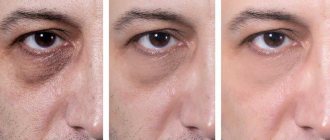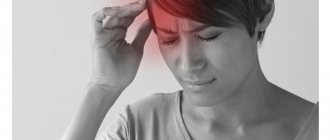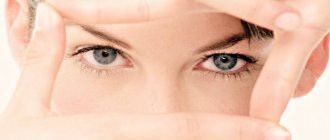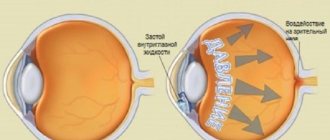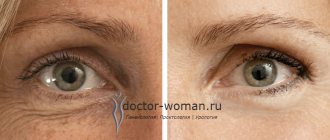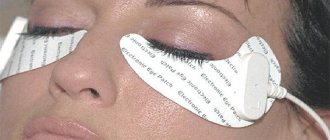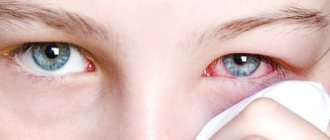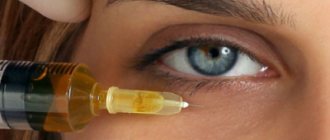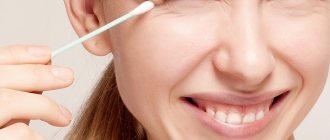Peeling of the skin around the eyes is not always caused by ordinary dry eyelids. This symptom occurs in a variety of pathological processes affecting not only the eyes, but the body as a whole. If you do not understand the reason that caused the peeling and immediately move on to moisturizing the skin, a person risks getting a latent course of the disease. This often leads to the development of complications. Therefore, before starting treatment, it is necessary to find out what exactly caused the peeling of the eyelids.
Cause of peeling under the eyes
Most often, peeling of the eyelid skin under the eyes is observed when exposed to the following conditions and diseases:
- lack of fluid intake into the body, which should be at least 2 liters per day;
- poor-quality nutrition, when the patient’s body receives a reduced number of vitamins, microelements and minerals necessary for the normal functioning of organs and systems, including the skin;
- prolonged exposure to the street in strong winds, frost, and frequent precipitation;
- avoiding the use of sunglasses to prevent damage to the skin around the eyes and the retina;
- the presence of frequent ophthalmological diseases of the external lining of the eyes (blepharitis, conjunctivitis, keratitis), the pathological process can begin on the mucous membrane of the organs of vision, but then move to the skin;
- dermatological diseases, for example, dermatitis, seborrhea, rosacea;
- allergic reactions leading to irritation and peeling of the skin; they can appear on flowering plants, animal hair, bird feathers, house dust, and chemicals.
Since there is a specific treatment for each cause of the condition, the doctor must identify the primary factor that caused the peeling. Only in this case is it possible to completely eliminate the symptom.
Folk ways to solve the problem
If peeling is not caused by internal problems, then it can be dealt with using traditional methods.
This is an excellent treatment option for an unpleasant symptom that was caused by a lack of vitamins or negative environmental influences. The first step is to carefully review your own diet. It should include foods that are fortified with micronutrients. Also, we must not forget about hydration, which is especially urgent for dry skin.
Signs of peeling around the eyes will disappear if you use the following folk recipes for caring for damaged skin.
Olive oil
Olive oil helps soften the affected areas. It needs to be warmed up a little before use. Soak a cotton pad in the oil and wipe the area under the eyes with it. After 10-15 minutes, the residue should be removed with a soft cloth, avoiding friction. Before washing off, it is advisable to dip it in warm water.
Curd mask
A mask made from 10 g of cottage cheese and 10 ml of vegetable oil will be useful. The ingredients are thoroughly mixed. The finished mixture should be applied to the desired area. After 10 minutes it is removed with a napkin.
Mask based on egg yolk and honey
A mixture of yolk, 30 g of natural honey and 30 g of vegetable oil helps to quickly achieve a positive result. The ingredients of the recipe are thoroughly mixed with each other. Afterwards, it is advisable to warm up the mass and apply it warm to certain areas or the entire area of the face. Requires 3 layers. Before applying the next one, make sure that the previous one has dried.
The treatment mask is kept for 20 minutes, after which it is removed with a napkin. It is advisable to moisten it in warm water or herbal decoction in advance.
flax family
A folk remedy made from flaxseed helps eliminate not only flaking, but also redness around the eyes. To prepare it, you need to pour 1 tsp. main ingredient 100 ml water. It must be hot. The product must be infused until the seeds become soft enough.
Afterwards, the resulting mixture is applied to problem areas and left for just a couple of minutes. Then the product is washed off with plain water.
Banana and honey
The nutritional composition, which is made from banana pulp, 10 g of honey, and a small portion of butter, proved to be on the good side. All ingredients are mixed together until they turn into a homogeneous mass. Afterwards, the mixture is applied to individual areas of the face and left for 25 minutes. It is best to remove such a mask with a damp cloth.
You can even fight eyelash mites at home. To eliminate the infection, you must use the following methods:
- Washing your face and smearing your eyelids with tar soap. This product must be used with caution as it can dry out the epidermis.
- Using compresses from linden decoction.
- Washing your face with a decoction based on oak bark or cabbage juice.
If after treatment with traditional methods the symptoms of skin lesions worsen, you should immediately stop therapy and go to an appointment with a dermatologist.
What to do if you notice a symptom
If the patient experiences the condition periodically and he knows what to do about it, self-treatment can be used. If the pathological symptom formed initially, or does not go away after prescribed treatment, you should consult a doctor.
An initial visit to a therapist is possible, who, after examining the patient, refers him to doctors of a narrow specialty.
This could be an allergist or dermatologist. It is also possible to independently contact a cosmetologist. After examining the affected areas and identifying the root cause using diagnostic tests, the doctor will prescribe a set of therapy. It may include the following actions:
- daily use of moisturizer, massage, thermal water;
- the use of cosmetic products to protect the skin from frost or ultraviolet radiation;
- drinking large amounts of liquid, it is better if it is ordinary water without gases;
- eating food that includes all the beneficial substances necessary for the body; if this is not enough, you can use multivitamin complexes if you are not allergic to one of the components of the product;
- exclusion from the patient’s life of all substances to which an allergic reaction may occur;
- antihistamines that can be used orally or topically (Suprastin, Cetrin, Erius, Claritin);
- non-steroidal anti-inflammatory ointments based on diclofenac;
- in case of severe inflammation and redness of the skin, you can use a steroidal anti-inflammatory agent for topical use, but only with the permission of a doctor;
- antibacterial, antiviral therapy in the presence of conjunctivitis, keratitis, blepharitis.
If an increased reaction of the body occurs to any component of drug therapy, it is recommended to immediately discontinue the drug and consult a doctor again to change therapy.
Treatment
Therapy is selected by the doctor depending on the severity of peeling and its cause. If, in case of slight drying of the skin after a long stay in the sun, it is enough to use chamomile infusion lotions, then in case of a fungal disease, medications are needed.
In case of an allergic reaction, you must first eliminate the allergen (cosmetics, food, pollen, etc.). If the allergy does not go away on its own, you should turn to antihistamines (Suprastin, Tavegil). There are ointments to relieve local symptoms, for example, Sudocrem or Lorizan. If the drugs are ineffective, consultation with an allergist is required.
Fungal infections, blepharitis, conjunctivitis, aspergillosis are treated with ointments that contain copper. In the initial stages, iodine or brilliant green is considered an effective remedy. In case of more severe pathology, the patient must undergo a course of antibiotic therapy in combination with sulfonamides (Fluconazole).
Peeling caused by an unbalanced diet requires a special diet. It is necessary to eat foods containing vitamins A and E. Vitamin-rich foods include:
- vegetable oil (vitamin E),
- parsley (vitamin A),
- salmon (B vitamins),
- citrus fruits (vitamin C).
These vitamins are sold as individual capsules at the pharmacy. Fried, salted, smoked, fatty and spicy foods should be excluded from the diet. To protect your eyelids from adverse weather conditions (wind, sun, rain, snow, dust, etc.), you can wear sunglasses. Men who work in hazardous industries should also have special protective equipment to prevent toxic and mechanical damage to the skin.
If you suspect eyelash mites, you should never self-medicate. The patient should contact an ophthalmologist to receive qualified medical care. This will avoid complications and speed up recovery.
Diagnosis of the real cause
When visiting a doctor, various types of diagnostics are performed to determine the exact cause of peeling and redness of the skin under the eyes:
- Anamnesis collection. The doctor determines whether the patient has an allergic reaction to any substance or whether close relatives have had it. The patient himself may complain of additional symptoms. For example, with keratitis, the quality of vision may decrease.
- General inspection. The doctor will notice severe peeling of the skin under the eyes, which may be red and irritated. Other symptoms of the disease may also appear. With conjunctivitis, severe redness of the eyes is detected. Keratitis may be accompanied by erosions on the cornea.
- Test for allergens in the autumn-winter period. Various substances are applied to the patient's wrist. If an inflammatory reaction is observed in any area of the skin, the doctor will determine the presence of an allergy.
- Superficial examination of the visual organs. The doctor determines whether the patient has inflammation of the eyelids, conjunctiva, cornea, and lacrimal canal area.
- Consultation with a dermatologist to examine the skin to identify inflammatory diseases.
If the peeling goes away after using a moisturizer, the reason may be a lack of moisture and nutrients. If peeling and redness of the skin is observed constantly, you cannot do without medical help.
Red eyes
You are missing: B vitamins
Red eyes occur when the small capillaries in the eyeball become inflamed and become filled with blood. And this, in turn, can be caused by a lack of vitamins B2 and B6. In addition, vitamins of this group are involved in the regulation of fluid outflow from the eye, while its excess also leads to impaired vascular function.
Where to get them
From dairy products, fish, meat (especially liver), avocado, walnuts. The daily norm is contained in approximately 200 grams of mackerel, or 45 nuts, or 5 tbsp. spoons of grated parmesan.
Lethargy, apathy
You are missing: iron
With the help of this trace element, the body produces the protein hemoglobin, the particles of which carry oxygen along with the bloodstream. The less hemoglobin, the less air the tissues of our body receive, and without O2 they cannot use energy and, accordingly, function normally.
Where can I get it?
The best source is red meat; the iron contained in it is absorbed faster and easier than from other products. Also press on dried fruits, eggs, citrus fruits and vegetables - the vitamin C they contain will also speed up the absorption of the microelement. But tea, on the contrary, will worsen it, so drink orange juice or fruit juice instead.
The daily dose of iron is contained in 15-20 figs or 100 grams of liver.
Tingling in muscles
You're missing: potassium
Potassium deficiency affects the conduction of our nerves, which leads to muscle weakness, as well as cramps and tingling.
Where can I get it?
In almonds, peanuts, hazelnuts, asparagus, kiwi, bananas and legumes. There is especially a lot of it in potatoes: to get the daily requirement, you need to eat baked potatoes, or 8 bananas, or 20 kiwi fruits. In addition, potassium levels are reduced by drinking alcohol, coffee and smoking.
Muscle cramps
You're missing: magnesium
This mineral is essential for transmitting nerve signals from the brain to the muscles and back.
Where can I get it?
Made from bran bread, whole grain pasta, brown rice, dried fruit, mushrooms and nuts. But: it is quite difficult to provide yourself with a daily dose from food alone; it is contained in 3 servings of spaghetti or 4 servings of rice, for example.
Therefore, doctors recommend taking dietary supplements and tablet vitamin complexes. Just make sure that they do not contain calcium, and your diet should contain less dairy products, fish and broccoli. Consumption of calcium interferes with the body's absorption of magnesium.
Dry skin
You lack: vitamin A
It is often added to creams and other skin care products, as it helps maintain skin elasticity and, in addition, accelerates the formation of new cells. But rubbing vitamins into your face is not the best way to get the maximum benefit from them. It is much cheaper and more effective to consume nutrients internally.
Where can I get it?
In fatty fish, eggs, dairy products, red, yellow and orange fruits and vegetables. The daily requirement is contained in one medium carrot or sweet pepper.
Smell from the mouth
You are missing: Vitamin C
And again the miracle ascorbic acid will save you. Vitamin C helps remove excess mucus and toxins from the body, the accumulation of which can cause unpleasant odor.
In addition, bad breath occurs when bacteria multiply in the oral cavity; to “get rid” of microbes, eat something “vitamin-rich” - for example, an orange or several berries of any kind - and most pathogens will die in an acidic environment. But keep in mind: this is not a cure, only a temporary solution. The most reliable way is to brush your teeth regularly after eating.
Cold palms and feet
What you're missing: Selena
Selenium is needed for the normal functioning of the thyroid gland, that is, it is involved in the production of many important hormones in the body. In particular, they regulate metabolism and maintain normal blood flow; and since the vessels in the extremities are narrowest and farthest from our heart, the slightest weakening of blood circulation immediately affects the temperature of our palms.
Where can I get it?
In nuts, seeds, legumes, fish, seafood. The daily requirement will be provided by 150-200 grams of cod or pink salmon.
Frequent cystitis
You are missing: Vitamin C
Recurrent inflammation of the genitourinary system is caused by bacteria, and can only be cured with medication. But to prevent infection, simple ascorbic acid will be enough. Studies have shown that consumption of vitamin C increases the acidity of the urinary tract mucosa and thereby makes it an unfavorable environment for the proliferation of microbes.
Where can I get it?
In citrus fruits, broccoli, red vegetables and berries. The daily dose of 60 mg is contained in one apple, or two small kiwis, or a glass of orange juice. However. There is no need to be afraid of an overdose: everything that you get in excess of your needs will be easily passed out in the urine.
PMS
You are missing: zinc
Zinc helps overcome hormonal changes, strengthens the health of the reproductive system and is even used in the treatment of infertility. Consequently, it is necessary for women on the eve of and during menstruation, especially since approximately a week and a half before the end of the cycle, its level in the body begins to gradually decrease. In turn, the production of progesterones and endorphins also decreases, and they are not for nothing called “hormones of happiness” and serve as natural painkillers and antidepressants.
Where can I get it?
In seafood, poultry, beef, cashews. The daily dose is just three oysters or 250 grams of beef.
